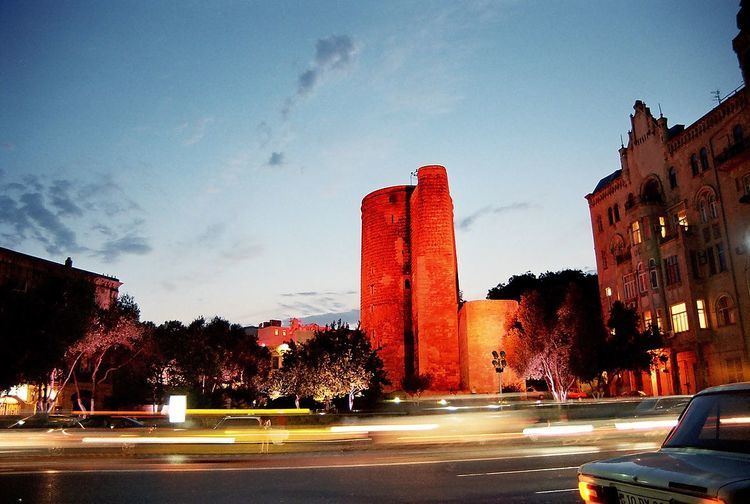 | ||
The architecture of Baku is not characterized by any particular architectural style, having accumulated its buildings over a long period of time.
Contents
- Islamic
- Russian Imperial and Azerbaijan Democratic Republic era
- Soviet architecture
- Late Modernism and Post Modern
- List of architects of Baku
- History
- Current developments
- References
In itself, Baku contains a wide variety of styles, progressing through Masud Ibn Davud's 12th century Maiden Tower and the educational institutions and buildings of the Russian Imperial era.
Late modern and postmodern architecture began to appear in the early-2000s. With the economic development, old buildings such as Atlant House have been razed to make way for new ones. Buildings with all glass shell appear around the city, with the most prominent examples being the SOCAR Tower and Flame Towers.
Several monuments pay homage to people and events in the city. The Martyrs' Lane provides views of the surrounding area whilst commemorating the victims of Black January and Nagorno-Karabakh War.
Islamic
With Shi'a Islam being the dominant religion of Azerbaijan, there are may Islamic architecture featured buildings that resides in Baku. Religious places have more Islamic calligraphy drawn on the columns and other places on the structure. In December 2000, the Old City of Baku, including the Palace of the Shirvanshahs and Maiden Tower, became the first location in Azerbaijan to be classified as a World Heritage Site by UNESCO.
Islamic buildings continued to be constructed in Baku also during the Imperial period. In particular, the Ajdarbey Mosque in then outskirts of the city was built in 1912-1913.
Russian Imperial and Azerbaijan Democratic Republic era
There are many buildings built in Baku at the turn of the 20th century that spot Victorian and Western influence in their designs. The city grew into one of the major industrial centres of the Russian Empire as oil fields attracted Russian and foreign investment.
Soviet architecture
USSR Council of Ministers' resolution "On measures to further industrialization, improving quality and reducing the cost of construction" and "The removal of excess in the design and construction" in mid-50's has helped to initiate mass housing in Baku.
The architectural image of the country's capital was enriched by a number of interesting in conception projects and highly significant in terms of urban sites, such as the building of the historical Ismailiyya building, which nowadays is the office of the Presidium of National Academy of Sciences of Azerbaijan, the Lenin Palace (now the Heydar Aliyev Palace), as well as marine and railway stations.
Late Modernism and Post-Modern
Baku’s new business districts today has shifted around the Baku city center where many new and tall buildings with Late Modernism and Postmodern architecture. Aside from buildings used for business and institutions, various new residential developments are currently underway, many of which consist of high-rise buildings with a glass exterior, surrounded by American-style residential communities.
List of architects of Baku
The architects of Baku have influenced the city's architecture throughout its development during the 19th and 20th centuries.
History
The names of numerous medieval architects of Baku are depicted on their buildings. One can mention the names of Masud ibn Davud, who designed Maiden Tower, his son Abdul-Majid Masud oglu, the author of the project of Sabayil Castle and Round Castle in Mardakan, Mahmud ibn Sa'ad, who built Bibi-Heybat Mosque, Nardaran Fortress and Mullah Ahmed mosque in Baku's Old City, etc.
Due to the oil boom in the 19th century, Baku became a rapidly developing city and grew rapidly. The large-scale construction of the city was directly tied to the increase of the city's population. Eventually, this brought numerous Armenian, Azerbaijani, German (Adolf Eichler and Nicolaus von der Nonne), Polish (Józef Gosławski and Józef Plośko) and Russian architects to the city, who ultimately influenced the city's architectural profile. Much of these architects were educated in Russia and, in particular, in St. Petersburg, Russia's capital city of the time. These included a number of high-profile designers, such as Freidun Aghalyan, Zivar bey Ahmadbeyov, Nikolai Bayev, Mammad Hasan Hajinski, and Hovhannes Katchaznouni. From 1860 till 1868, Gasim bey Hajibababeyov was considered the chief architect of Baku.
Architects during the Soviet period include Mikayil Huseynov, Sadig Dadashov, Lev Ilyin, Lev Rudnev etc. In Baku also worked architects Hasan Majidov, who designed the building of Museum center, Talaat Khanlarov, the author of Heydar Aliyev Sports and Exhibition Complex, Anvar Qasimzade, who designed the building of the Oil and Gas Research and Design Institute (1956) and Ulduz metro station.
Current developments
As a developing city largely influenced by economic oil boom, there are many construction projects that are currently being built that will change the city's skyline in the near future. Some of the construction project are SOCAR Tower, Crescent Bay Hotel, Baku White City, Baku National Stadium, Full Moon Hotel, Baku Hilton Hotel, and the Four Seasons Hotel. A lot of the new development has come at the cost of old Soviet-era existing structures. The destruction of the Soviet heritage has created controversy, such as the recent destruction of the Soviet-era 26 Commissars Memorial in 2009 to make way for a new car park.
In 2011, Discovery channel's Extreme Engineering program featured these projects that are under construction in Baku.
